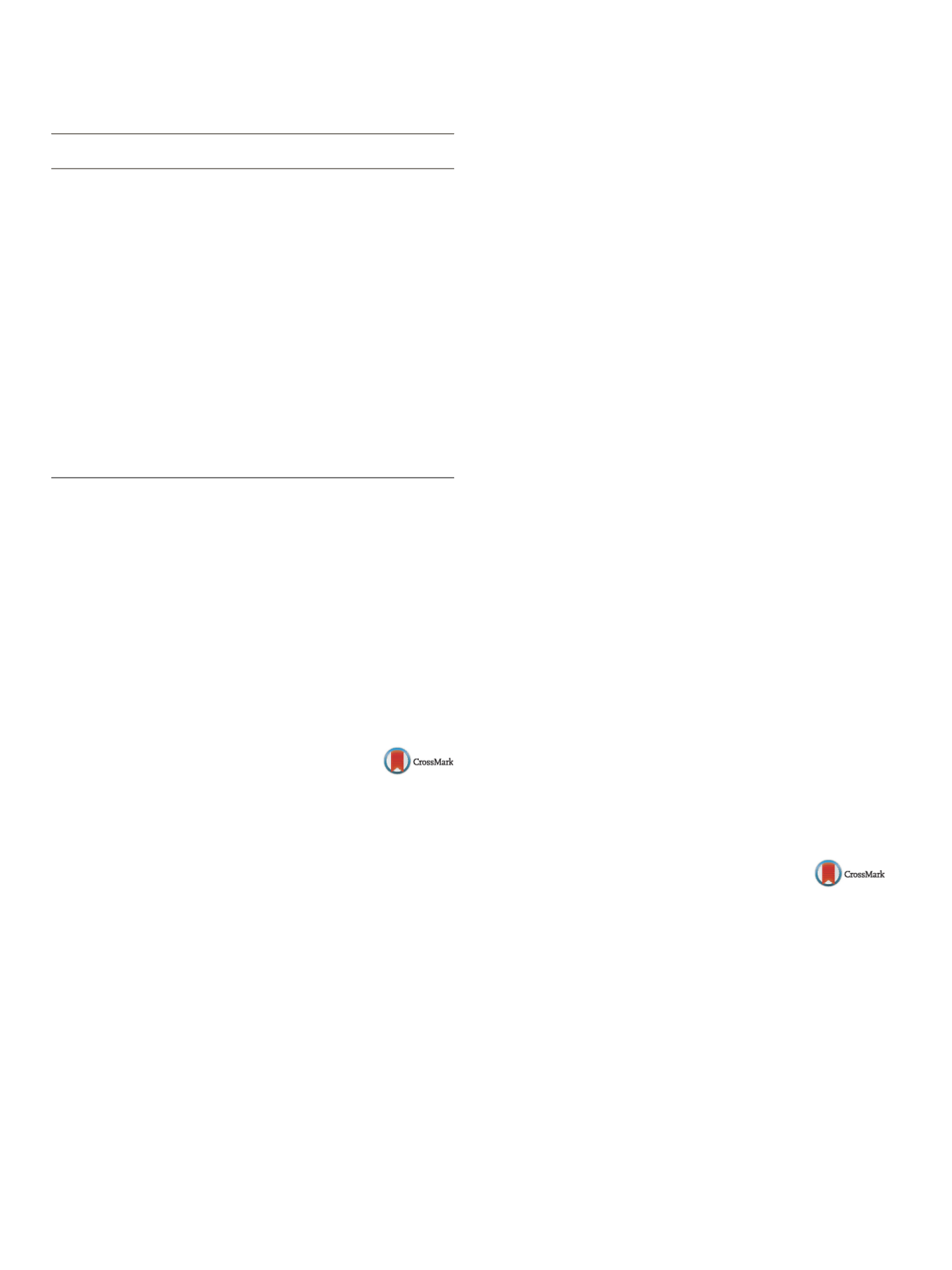

S126
Abstracts / Journal of Clinical Virology 82S (2016) S1–S142
Table 1
Demographic and clinical characteristics of 42 ICU patients with ARI and positive
for viral pathogen.
Characteristics
Children
(
n
= 28) (%)
Adult (
n
= 14)
(%)
Total (
n
= 42)
(%)
Male
13 (46.4)
10 (71.4)
23 (54.8)
Female
15 (53.6)
4 (28.6)
19 (45.2)
Age, median (range)
49.5 day (4
day–15.4 year)
52.7 year
(23–84 year)
1.33 year (4
day–84 year)
Pneumonia
7 (25.0)
5 (35.7)
12 (28.6)
Respiratory failure
12 (42.8)
8 (57.1)
20 (47.6)
Bronchiolitis
5 (17.8)
0 a5 (11.9)
Other
4 (14.3)
1 a5 (11.9)
Oxygen support
15 (53.6)
12 (85.7)
27 (64.3)
Mechanical ventilation 4 (14.3)
9 (64.3)
13 (30.9)
Mortality rates
2 (7.1)
4 (28.6)
6 (35.7)
INF viruses
9 (32.1)
12 (85.7)
21 (50.0)
INF A/H1
3 (10.7)
8 (57.1)
11 (26.2)
INF A/H3
2 (7.1)
1 a4 (9.5)
INF A
1 a 1 a2 (4.8)
INF B
3 (10.7)
2 (14.3)
7 (16.6)
Rhinovirus
9 (32.1)
5 (35.7)
14 (33.3)
RSV
9 (32.1)
4 (28.6)
13 (30.9)
Parainfluenza virus 1, 3 3 (10.7)
1 a4 (9.5)
Adenovirus
2 (7.1)
1 a3 (7.1)
Metapneumovirus
1 a0
1 aViral coinfections
5 (17.8)
6 (42.8)
11 (26.2)
a
Not calculated.
viral pathogens (50.0%), especially among adults (85.7%). In chil-
dren, influenza viruses, RSV and rhinovirus (32.1%) were detected
frequently
( Table 1 ).Conclusion:
Respiratory viruses are significant causes of severe
ARI in adults and young children during the winter season. Early
recognition of viral pathogens in ARI etiology is important in order
to diagnosis and management of severe ARI in ICUs.
http://dx.doi.org/10.1016/j.jcv.2016.08.251Abstract no: 332
Presentation at ESCV 2016: Poster 212
Identification of mutations in surface
glycoprotein genes of human respiratory
syncytial virus in children treated with
palivizumab
A. Flammang
1 ,∗
, J. Hamel
1 , 2, J. Brouard
3 , 4,
L. Adamon
5, A. Vabret
1 , 2 , 4, J. Dina
1 , 2 , 41
CHU de Caen, Department of Virology, Caen
F-14000, France
2
National Reference Center for Measles and
Respiratory Paramyxovirus, France
3
CHU de Caen, Department of Pediatrics, Caen
F-14000, France
4
Université Caen Normandie, Medical School, Caen
F-14000, France
5
CHU de Caen, Department of Neonatology, Caen
F-14000, France
Background:
Palivizumab is a respiratory syncitial virus (RSV)-
neutralizingmonoclonal antibody clinically used for the prevention
of severe RSV infections in high-risk infants, preterm infants and
infants with hemodynamically significant heart disease or chronic
lung disease. Palivizumab acts by blocking the fusion step of virus
replication. Mutants resistant to palivizumab were isolated in vitro
and also in childrenwithRSV infectionwhile receiving palivizumab.
The mutations reported are situated on the fusion protein (amino
acids 262–276), in the liaison site of the palivizumab. It seems
that mutations out of the liaison site do not confer resistance
to palivizumab. The gene coding for the attachement glycopro-
tein (G gene) was rarely sequenced. The aim of this study was
to analyze the complete F and G genes sequences coding the sur-
face glycoproteins of RSV isolates collected from patients receiving
palivizumab.
Material and methods:
RSV isolates were obtained from
nasopharyngeal swabs of high-risk infants treated with
palivizumab at the University Hospital of Caen between October
2011 and April 2016 and having presented a RSV-breakthrough
during the treatment or in the six months after. RSV controls were
obtained from infants who did not receive palivizumab. Viral ARN
was extracted using Qiasymphony DSP Virus/Pathogen Mini kit
®
.
The group typing of hRSV, A or B, was completed using real time
RT-PCR. The amplification and sequencing of the complete F and
G genes were performed using One-Step RT-PCR kit
®
(Qiagen,
Hilden, Germany) and specific primers and protocols. The analysis
and comparison of the obtained sequences with reference strains
and control sequences were performed with BioEdit
®
software.
Phylogenetic tree were constructed by the neighbor-joining
method in MEGA 6.0
®
software.
Results:
Among the 273 infants treatedwithpalivizumab during
the period of the study, 15 (8.4%) have presented a RSV infection
during their treatment or in the six months after. Seven RSV/A and
8 RSV/B were identified by real-time PCR. The amplification and
sequencing of the F and G genes were successfully undertaken.
For the RSV/A analysis, phylogenetic trees were constructed
using 6 RSV/A detected, one control RSV/A and 42 reference
sequences. The hRSV/A isolated in 2014 or after were identified in
the ON1 cluster. When they were detected in 2011 they clustered
with the GA2 genotype. None RSV/A was detected between 2011
and 2014.
The analysis of complete F genes alignments of hRSV/A shows
several mutations out of the liaison site of palivizumab. We found
one mutation in the liaison site, the N276S mutation. This was
previously described as a mutation conferring partial resistance to
palivizumab
in vitro
and
in vivo
. This mutation was also identified
in the viruses collected from the control population.
Conclusion:
This study allowed us to characterize mutations of
RSV in case of palivizumab treatment failure.
http://dx.doi.org/10.1016/j.jcv.2016.08.252Abstract no: 340
Presentation at ESCV 2016: Poster 213
The use of in vitro human airway epithelia for
the development of novel antivirals
S. Huang
1 ,∗
, S. Benaoudia
1, R. Bonfante
1,
B. Boda
1, M. Essaidi-Laziosi
2, L. Wisniewski
1,
L. Kaiser
2, C. Tapparel
2, S. Constant
11
Epithelix, Geneva, Switzerland
2
Laboratory of Virology, University of Geneva
Hospitals, Switzerland
The human airway epithelium occupy a central position in
the pathogenesis of respiratory viruses. As the first line of
defense against microorganisms, epithelia cells reacts through
mucus secretion, mucociliary clearance, activation and release of
chemokines, cytokines, lipids, growth factors, proteases, etc.
Viral respiratory infections are the most frequent etiologies of
acute illnesses worldwide and causemild to severe diseases such as
common cold, bronchiolitis and pneumonia. A comparative study
was carried out on the infectivity and replication of the most
frequent human respiratory viruses using standardized
in vitro


















